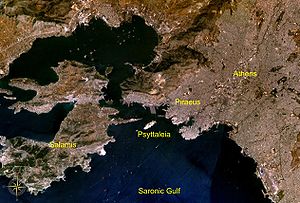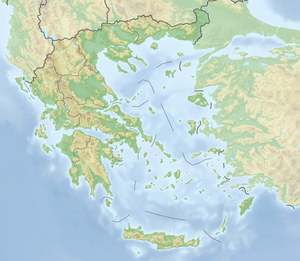Psyttalia
| Psyttalia (Ψυττάλεια) | ||
|---|---|---|
| Satellite image of Psyttalia and the surrounding area | ||
| Waters | Saronic Gulf , Mediterranean | |
| Archipelago | Saronic Islands | |
| Geographical location | 37 ° 56 '30 " N , 23 ° 35' 17" E | |
|
|
||
| length | 475 m | |
| width | 1.52 km | |
| surface | 37.5 ha | |
| Highest elevation | 45 m | |
| Residents | uninhabited | |
Psyttalia or Psyttaleia ( pronunciation : [ psiˈtalja ], Greek Ψυττάλεια ( f. Sg. )) Is an uninhabited small island in the Saronic Gulf in Greece , on which a huge sewage treatment plant was built for the greater Athens area .
geography
Psyttalia is a 0.375 km² island, which originally consists of limestone and clay . The island is located 2.2 km south of the coast of Keratsini , a suburb of Piraeus , midway between the port of Piraeus and Salamis Island. Administratively, the island belongs to Piraeus.
Naming and identification
The island was called Lipsokoutala or Lipsokoutali until the 20th century . From the ancient descriptions of the Battle of Salamis it was concluded that this was the island called Psyttalia in ancient times. There were also researchers who identified the island of Agios Georgios, located about 5 km to the northwest, as Psyttalia. The identification of Psyttalia with Lipsokoutali is now considered certain.
The island was called Psyttalia until around the 12th century. Michael Choniates , the Metropolitan of Athens, was the last to call them that. This name is said to be derived from the Greek psytt-allos and literally mean 'spat out from the sea'. Under Frankish rule the name Lipsokoutali ( Greek Λειψοκουτάλι ) prevailed. This name should mean little spoon - which should allude to the shape of the island; The island has a different shape today, as a bay was filled in to build the sewage treatment plant in the north and in the south-east. Another interpretation assumes that the island was called Le Psyttalia by the Franks and that Lipsokoutali was formed from it over time . In the 20th century the island, like many other places, got its ancient name again.
history
During the work on the island that created space for the biological sewage treatment plant, marine fossils were found in the limestone.
The island became famous during the Battle of Salamis in 480 BC. The Persian fleet had taken position at Psyttalia and had 400 soldiers stationed on the island. These were to assist allied ships that fled here and put down the crews of enemy ships that landed. However, the Persian fleet was defeated and fled. The Greeks now surrounded the island with their ships and initially provided the Persians with a hail of stones and arrows. In the meantime, Aristeides of Athens had taken Athens hoplites from Salamis on board with his ships and set them down on Psyttalia. These killed the remaining Persians except for a few nobles who took them prisoner. Among them were three sons of Sandauke, the sister will of Xerxes I , have been located. On the instruction of the seer Euphrantides, they were finally sacrificed to Dionysus Omestus.
Plutarch reports that a victory sign was erected on Psyttalia. Foundations that fit this description were found on the northwestern peninsula. Pan was also worshiped on the island . Some black glazed and Roman ceramic shards were found on the peninsula. The place was visited by pilgrims from classical to Roman times. In the early Byzantine period (6th – 7th centuries BC) a settlement was established on the peninsula.
Several people were buried on Psyttalia in the 19th century. In 1835 Louise von Armansperg († September 11, 1835), the daughter of the Greek Prime Minister Joseph von Armansperg , found her final resting place in the north near the lighthouse Nisos Psyttalias . Four tombs can still be seen on the peninsula today. The grave of the French captain Michel-Joseph-Guillaume de Rabaudy († July 19, 1837) is crowned by an obelisk . Next to it are the grave monuments of the French Theodore-Thomas Vrenière († September 11, 1845) and the English Samuel Ragg († February 22, 1850). One of the graves has no inscription. A prison of the Greek navy was built on the island that lasted until the middle of the 20th century. In 1986 the archaeologist Vasilios Petrakos carried out systematic excavations.
Sewage treatment plant
The island was completely remodeled from 1990 onwards to treat Athens' sewage . To this end, a small bay on the north side of the island was first filled with two million cubic meters of excavated material. Then the KELPS sewage treatment plant was built on the island for the wastewater of the greater Athens area.
capacity
The sewage treatment plant on the island of Psyttalia is the second largest in Europe and one of the largest in the world. Municipal and pre-treated industrial wastewater from the greater Athens area with around 5.6 million inhabitants is treated here. Most of the wastewater flows to a pumping station on the coast, where it is pumped to the island by nine gigantic Archimedean screw pumps.
The capacity is one million cubic meters of wastewater per day, i.e. around twelve cubic meters per second; In 2006, an average of 705,000 cubic meters of wastewater was treated per day. The system complies with the EU waste water treatment directive for 2020.
Building history
- Phase A : Until 1994, when the first plant on Psyttalia was commissioned, most of Athens' domestic and industrial wastewater was discharged without any treatment, which led to serious chemical and bacterial pollution. With the completion of phase A, the primary stage, in 1994, the pollution in the wastewater was reduced by 35 percent. Since then, the plant has provided initial treatment, which includes filtering, desanding, primary clarification, anaerobic treatment and mechanical dewatering of the sewage sludge . The treated wastewater was then disposed of via pipelines 2000 m away at a depth of 64 meters.
- Phase B : In order to comply with the stricter limit values for nitrogen that the European Union directive for municipal wastewater treatment provided for, a significant improvement was necessary. Before the EU-funded armament, which cost 200 million euros, the Saronic Gulf was viewed as critical by the EU. By implementing phase B, the secondary biological stage, in summer 2004, it was possible to reduce pollution by 93 percent and the amount of nitrogen by tertiary treatment by 80 percent. A total of four million cubic meters of earth was cleared to make room for the biological sewage treatment plant. Large 9.4 m high bioreactors and aeration tanks were also built. The technical upgrade included a biological treatment that removes organic, environmentally harmful carbon, nitrogen and phosphorus compounds . The sewage treatment plant has thus significantly improved the water quality and the environmental conditions in the Saronic Gulf.
- Sewage sludge drying : The Psyttalia sewage treatment plant produces around 800 tons of sewage sludge every day . This was last temporarily stored on the plant site, while it had previously been taken to the Ano Liossia landfill . The interim storage of sewage sludge posed significant risks to public health and the environment and was in breach of relevant EU regulations. There has recently been a new thermal sewage sludge drying plant, the construction of which was supported by EU funds and which has been operational since September 2007. This restored the compliance of the sewage treatment plant operation. The plant consists of four drying lines with a total capacity of 34.5 tons of water evaporation per hour - this corresponds to 300 tons of dried sludge per day. The system is energy efficient and consumes an average of 917 kilowatt hours of thermal energy per ton of evaporated water. Up to 80 percent of the energy requirement is recovered from combined heat and power . After the odor treatment, the exhaust gases are minimized by regenerative post-combustion and then released into the atmosphere. The remaining dried sewage sludge is shipped to the mainland and disposed of.
The plant is to be expanded further by 2026; then the Saronic Bay is to be gradually restored to a zone suitable for fishing and leisure activities.
literature
- Peter W. Haider: Psyttaleia in Siegfried Lauffer : Greece. Lexicon of historical sites from the beginning to the present. CH Beck, Munich 1989, ISBN 3-406-33302-8 .
Individual evidence
- ↑ Paul W. Wallace: Psyttaleia and the trophies of the Battle of Salamis in American Journal of Archeology , Volume 73, No. 3, July 1969, pp 293-303..
- ^ Pausanias : Travels in Greece , 1,36,2
- ↑ Herodotus : Historien , 8.76
- ↑ Aeschylus : The Persians , 447–471
- ↑ Herodotus: Historien , 8.95
- ^ Pausanias: Travels in Greece , 4,36,6
- ↑ Plutarch : Aristeides , 16.4
- ↑ Plutarch: Aristeides , 16.4
- ^ Pausanias: Travels in Greece , 1,36,2
- ↑ Aeschylus: The Persians , 447–471
- ↑ Paul W. Wallace: Psyttaleia and the Trophies of the Battle of Salamis in American Journal of Archeology , Volume 73, No. 3, July 1969, pp. 302-303.
- ↑ Ο Τάφος της Λουίζας Άρμανσμπεργκ στην Ψυττάλεια
- ↑ Islet of Atalanti ( online )
- ^ AP Grimanis et al., Pollution studies of trace elements in sediments from the Upper Saronikos Gulf, Greece . In: Journal of Radioanalytical and Nuclear Chemistry 1977, p. 761 (English)
- ↑ Efstratiou et al., Correlation of bacterial indicator organisms with Salmonella spp., Staphylococcus aureus ans Candida albicans in sea water . In: Letters in Applied Microbiology 1998, doi : 10.1046 / j.1472-765X.1998.00345.x (English)
- ↑ Directive 75/442 / EEC on waste ( Memento of the original from September 27, 2007 in the Internet Archive ) Info: The archive link was automatically inserted and not yet checked. Please check the original and archive link according to the instructions and then remove this notice. and Directive 91/271 / EEC on the treatment of municipal wastewater ( Memento of the original dated December 7, 2008 in the Internet Archive ) Info: The archive link was automatically inserted and has not yet been checked. Please check the original and archive link according to the instructions and then remove this notice. (PDF; 177 kB)
- ↑ Environmental protection: EU Commission takes further legal measures against Greece for breach of contract. EU Commission, January 31, 2008, accessed on July 5, 2010 .
- ↑ Website of the Athens Water Supply and Sewerage Company (EYDAP SA) (English) ( Memento of the original from October 23, 2007 in the Internet Archive ) Info: The archive link was automatically inserted and not yet checked. Please check the original and archive link according to the instructions and then remove this notice.

